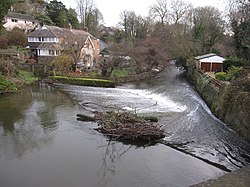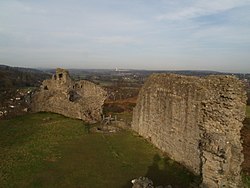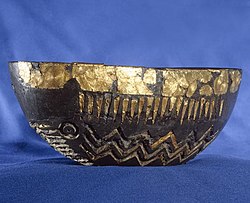Caergwrle
| Caergwrle | |
| Flintshire | |
|---|---|
 The River Alyn in Caergwrle | |
| Location | |
| Grid reference: | SJ303575 |
| Location: | 53°6’37"N, 3°2’26"W |
| Data | |
| Population: | 1,619 (2011 (ward)) |
| Post town: | Wrexham |
| Postcode: | LL12 |
| Dialling code: | 01978 |
| Local Government | |
| Council: | Flintshire |
| Parliamentary constituency: |
Alyn and Deeside Delyn |
Caergwrle is a village in Flintshire, approximately fix miles from Wrexham in neighbouring Denbighshire. It is situated on the A541 road, and is contiguous with the villages of Abermorddu and Hope, though in parts Caergwrle and Hope are separated by a river border. The village lies on the River Alyn and sits at the base of Hope Mountain. At the 2001 Census, the population was 1,650.[1] The population of this ward as taken at the 2011 census was 1,619.[2] The ward includes the area of Abermorddu. Further south is the village of Cefn-y-bedd.
Contents
History
The 13th-century, ruined Caergwrle Castle was first built by Prince Dafydd ap Gruffydd, in lands agreed with Edward I during his invasion of Wales in 1277. Dafydd, in agreeing not to resist the invasion, had extensive improvements made to his castle at Edward's expense. In 1282 however, Dafydd bought his time and raised the banner of revolt, marching on Hawarden Castle controlled by Edward's invaders. Dafydd and his men seized the castle. Dafydd's brother, Llywelyn ap Gruffydd the Prince of Wales, was then drawn into what became the Welsh Wars of Independence. When Llywelyn was beheaded by one of Edward's mercenaries in 1282, Dafydd ap Gruffydd then became Prince of Wales from 11 December 1282 until his execution on 3 October 1283 by King Edward I.
The village originally had the English placename of Corley, but with the addition of the Welsh placename epithet "Caer", meaning "fortress", the name gradually took on Welsh spelling. To explain the name, a myth developed of a giant named Gwrle, who was supposed to have lived in the castle and been buried in the nearby Neolithic burial mound at Cefn-y-bedd.[3][4]
The 17th-century Packhorse Bridge, which is reputed to be haunted,[5] was nearly destroyed by flooding in 2000, though it has since been restored. There have been many other developments and restorations in Caergwrle.
Caergwrle is also home to a Welsh International football player George Alfred Godding who played from 17 March 1923 to 14 April 1923 with two caps for Wales.
Caergwrle's long association with the adjacent village of Hope has given rise to a well-known local joke: "Live in Hope, die in Caergwrle".[6] This was already described as an "old saying" in the 19th century, when it was recorded by the antiquarian John Askew Roberts.[7]
Transport
Rail
The service from Wrexham Central to Bidston passes through Caergwrle railway station. Bidston provides a connection to Liverpool via the Wirral Line.
Bus
Caergwrle has bus links giving access to Mold, Broughton, Wrexham and Chester.
Food and drink in Caergwrle
There are two pubs in Caergwrle, the Crown Inn and Ye Old Castle Inn. These pubs have their own pool and darts teams. The Bridge Inn, formerly a pub and a fully licensed Chinese restaurant, latterly renamed to Po Po Pang, a fully licensed Malaysian/Chinese restaurant, has closed as a daily business but opens for private bookings. Honey's Bakery to the rear of Po Po Pang is a café which is open daily. The Darby Arms and Half Way Inn have been closed for some years and are now private residences. The Glynn Arms became a Nursing Home many years ago.
The Caergwrle Bowl
The Caergwrle bowl is a unique object dating to the Middle Bronze Age, originally manufactured from shale, tin and gold. It is thought to represent a boat, with its applied gold decoration signifying shields, oars and waves. The incomplete bowl was found in 1823 by a workman digging a drain in a field below Caergwrle Castle. It was donated to the National Museum Wales in 1912, and sent to the British Museum for restoration where it was originally reconstructed from wax with the decoration attached by an adhesive. Since then the bowl has been rebuilt again as the first conservation failed to be stable.[8]
References
- ↑ "2001 Census: Caergwrle". Office for National Statistics. http://neighbourhood.statistics.gov.uk/dissemination/LeadKeyFigures.do?a=3&b=6074188&c=Caergwrle&d=14&e=16&g=414430&i=1001x1003x1004&m=0&r=1&s=1215016508267&enc=1.
- ↑ "Ward population 2011". http://www.ukcensusdata.com/caergwrle-w05000191#sthash.OQovOWFd.dpbs.
- ↑ Hywel Wyn Owen (1998). The Place-Names of Wales. ISBN 0-7083-1458-9.
- ↑ Stephen Rule via Megalithic Portal. "Cefn-y-bedd Burial Chamber". http://m.megalithic.co.uk/article.php?sid=46464.
- ↑ "Ghost 'caught' on Packhorse Bridge". BBC. 2009-07-30. http://news.bbc.co.uk/local/northeastwales/hi/people_and_places/history/newsid_8176000/8176747.stm.
- ↑ The AA touring guide to Wales, Automobile Association, 1975, p.205
- ↑ Roberts, J. A. (1883). Gossiping Guide to Wales. Simpkin, Marshall, Hamilton, Kent & Co. p. 66. https://archive.org/details/gossipingguidet00woodgoog.
- ↑ Davis, Mary "Re-conserving the Caergwrle Bowl
Outside links
| ("Wikimedia Commons" has material about Caergwrle) |

